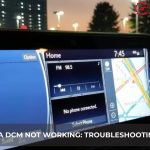If you’re a Hyundai owner, you may have noticed the “Check AEB System” warning light on your dashboard. This warning light is related to your vehicle’s Autonomous Emergency Braking (AEB) system, which is responsible for preventing frontal collisions. A malfunctioning AEB system can compromise your safety, so it’s important to understand what this warning light means and how to address it.
The AEB system in your Hyundai uses radar, cameras, or Lidar to detect incoming collisions and automatically apply the brakes to prevent them. If the AEB system isn’t functioning properly, it may trigger the “Check AEB System” warning light. There are several potential causes of this warning light, including dirty sensors, faulty ABS sensors, worn-out brake pads, or other issues with the AEB system itself.
In this guide, we’ll explore the meaning of the “Check AEB System” warning light on your Hyundai dashboard and provide actionable steps for troubleshooting and resolving any issues. Whether you have a Hyundai Elantra or another model, this guide will help you understand your AEB system and keep it functioning optimally to ensure your safety on the road.
Decoding the “Check AEB System” Warning
The “Check AEB System” warning light serves as an alert that your Hyundai’s AEB system might not be functioning properly. This doesn’t necessarily mean complete failure, but it indicates a potential issue requiring attention. Here’s what you need to know to decode this warning.
Sensor Issues
Most Hyundai AEB systems rely on a front-mounted radar sensor to detect potential collisions with vehicles ahead. If the warning light appears after situations where the radar sensor could have been obstructed, it could be due to the following reasons:
Dirt, Debris, or Snow Accumulation
Build-up on the radar sensor can disrupt its ability to detect objects. Regular cleaning of the sensor can help prevent this issue.
Sensor Misalignment
A misaligned sensor might not be pointed in the correct direction, affecting its functionality. If you suspect this is the cause, consult a professional technician.
Faulty Radar Sensor
In rare cases, the sensor itself might be malfunctioning. A professional technician can diagnose and replace the sensor if necessary.
Camera Issues
Some Hyundai models incorporate a forward-facing camera alongside the radar sensor for a more comprehensive AEB system. If the warning light illuminates, it could be due to the following reasons:
Windshield Dirt or Debris
Obstructions on the windshield can block the camera’s view, hindering its ability to detect objects. Regular cleaning of the windshield can help prevent this issue.
Camera Misalignment
A misaligned camera might not be capturing the necessary information for the AEB system. If you suspect this is the cause, consult a professional technician.
Faulty Camera
Similar to the radar sensor, the camera itself could be malfunctioning. A professional technician can diagnose and replace the camera if necessary.
Other Potential Causes
In some instances, outdated or malfunctioning software within the AEB system might trigger the warning light. Faulty wiring or electrical problems could also disrupt communication between the AEB system components, leading to a malfunction. If you suspect either of these issues, consult a professional technician.
Responding to the “Check AEB System” Warning
If you see the “Check AEB System” warning on your Hyundai, don’t panic. Follow these simple steps to troubleshoot the issue:
Consult Your Owner’s Manual
Your Hyundai owner’s manual will provide specific information about the AEB system and any troubleshooting steps recommended by the manufacturer. Make sure to review the manual to understand the warning and the recommended steps to resolve it.
Perform a Visual Inspection
Check the front radar sensor and forward-facing camera (if equipped) for any visible dirt, debris, or damage that might be obstructing their view. If you have a Hyundai Elantra, you might also see a headlight warning light. Make sure to check the headlights as well.
Clean the Sensor(s) and Camera (if applicable)
Use a soft, damp cloth to gently clean the sensor and camera, ensuring a clear view. If you have a Hyundai Elantra, you might need to check the headlight bulbs as well.
Schedule Service Appointment
If the warning light persists after cleaning or you suspect a more complex issue, schedule an appointment with a qualified mechanic or Hyundai dealership for proper diagnosis and repair. They will be able to identify the root cause of the issue and provide a solution.
Maintaining Your Hyundai’s AEB System
To ensure that your Hyundai’s AEB system functions properly, it is important to perform regular preventative maintenance. Here are some tips to help you keep your AEB system in good working order:
Preventative Maintenance
Regularly inspect the radar sensor and camera (if equipped) for signs of damage or debris buildup. Clean them periodically using a soft, damp cloth. This will help to ensure that the AEB system can detect obstacles in its path and respond accordingly.
If you notice that the headlight warning light on your Hyundai is illuminated, it may be an indication that there is an issue with the AEB system. In this case, it is recommended that you have your vehicle inspected by a qualified technician.
Software Updates
Stay up-to-date on any software updates recommended by Hyundai for your specific model. These updates can sometimes address AEB system glitches and improve the overall performance of the system.
If you notice that the headlight warning light on your Hyundai Elantra is illuminated, it may be an indication that there is a software issue with the AEB system. In this case, it is recommended that you contact your local Hyundai dealership to inquire about any available software updates.
Refer to Owner’s Manual
Consult your owner’s manual for any specific maintenance recommendations related to the AEB system in your Hyundai. This will help you to understand how to properly care for your AEB system and ensure that it functions properly.
If you are uncertain about how to properly care for your AEB system or have any questions about its operation, it is recommended that you contact your local Hyundai dealership for assistance.
Conclusion
In conclusion, the AEB system in Hyundai cars is an advanced safety feature that automatically applies brakes to prevent collisions. It is a form of collision avoidance technology used in Hyundai’s and other modern vehicles. The AEB system makes use of radar, cameras, or Lidar to be able to detect incoming collisions. Any obstruction to the tracking technology will affect how the AEB functions.
If you encounter the “Check AEB System” warning, the first step is to check if the AEB system is turned on. If yes, then try resetting the AEB warning system. In case of a faulty ABS sensor, replace it immediately to fix the warning light. Another possible cause of the warning light could be worn-out brake pads. Try replacing them and see if the warning light disappears.
To check the ABS system on a Hyundai Elantra, turn on the ignition and look for the ABS light on the dashboard. If the light stays on or flashes, there may be an issue with the system that requires further inspection. Additionally, the Hyundai Elantra headlight warning light could also indicate a problem with the headlight system that requires attention.
Related Posts:







